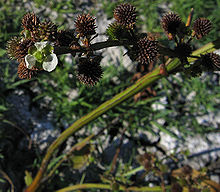
Echinodorus, commonly known as burhead or Amazon sword, is a genus of plants in the family Alismataceae, native to the Western Hemisphere from the central United States to Argentina. Its scientific name is derived from Ancient Greek echius – "rough husk" - and doros – "leathern bottle" - alluding to ovaries, which in some species are armed with persistent styles, forming prickly head of fruit. Some of the species are commonly cultivated in artificial aquatic habitats.

Echinodorus cordifolius, the spade-leaf sword or creeping burhead, is a species of aquatic plants in the Alismatales. It is native to Mexico, the West Indies, Central America, South America and the southeastern United States.

Echinodorus horizontalis is a species of plant in the Alismataceae family. It is native to northern South America.

Echinodorus tunicatus is a species of aquatic plants in the family Alismataceae.

Echinodorus longiscapus is a perennial, aquatic plant of the Alismataceae, native to South America. It is cultivated as a pond or aquarium plant.

Echinodorus macrophyllus is a species of aquatic plants in the Alismataceae. It is native to Brazil and Bolivia.
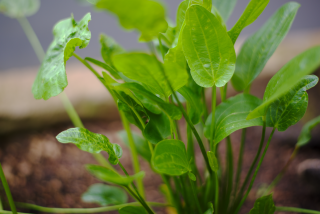
In Rataj's taxonomy Echinodorus ovalis is in Section Cordifolii, Subgenus Echinodorus. It is related to Echinodorus cordifolius and listed by some authorities and importers as a synonym of that species, e.g. E. cordifolius 'ovalis'.
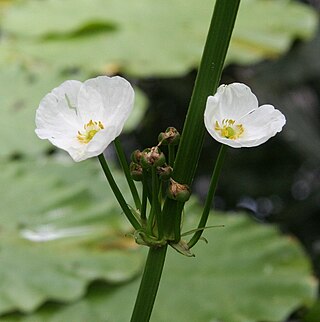
Echinodorus subalatus is a species of aquatic plants in the Alismataceae. It is native to Cuba, Mexico, Central America, Guyana, Venezuela, Bolivia, Brazil and Paraguay. It is found naturally growing in mud by the side of streams.
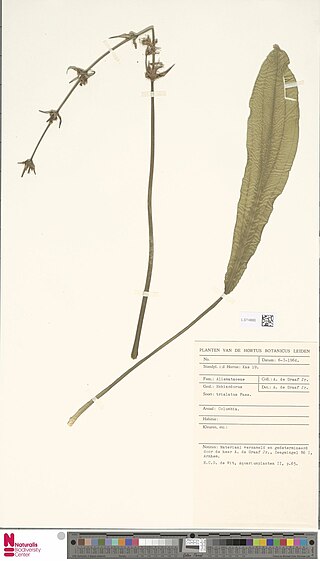
Echinodorus trialatus is a type of plant. In Rataj's taxonomy, E. trialatus is in Section Paniculati, Subgenus Echinodorus.

Echinodorus uruguayensis is a plant species in the Alismataceae. It is native to South America.
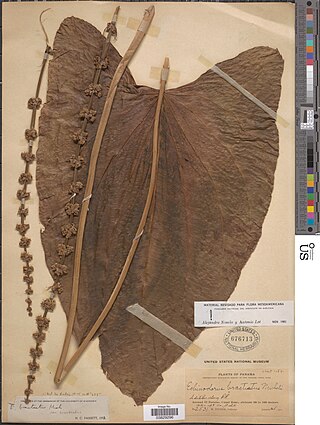
Echinodorus bracteatus is a species of plants in the Alismataceae. It is native to Costa Rica, Nicaragua, Panama, Colombia and Ecuador.
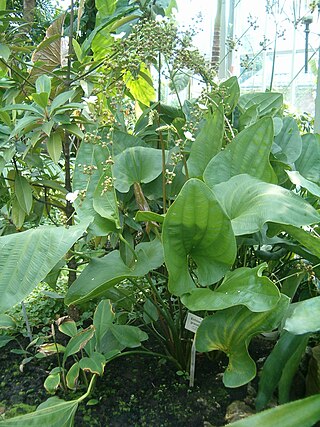
Echinodorus grandiflorus is a plant species in the Alismataceae. It is native to Brazil, Paraguay, Uruguay, Argentina, Venezuela and Florida.
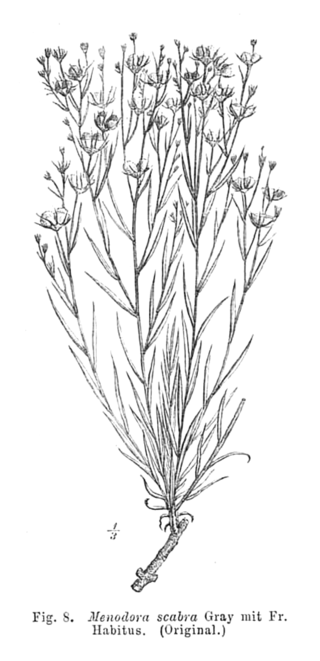
Menodora scabra is broom-like shrub in the Olive Family (Oleaceae), known by the common name rough menodora or broom twinberry. It is a popular desert garden plant.
Aponogeton abyssinicus is an amphibious plant found in east and central Africa, from Ethiopia to Malawi and Zaire. Root stock tuberous or oblong, up to 2.5 cm diameter. Submersed leaves initially strap-shaped, up to 12 cm long and 6 mm wide, continuing lanceolate to obovate, up to 8.5 cm long, 2.6 cm wide and up to 10 cm long petiolate. Blade thin and slightly transparent, with a narrowing or decurrent base and acute or obtuse apex. Adults floating, up to 50 cm long petiolate. Floating leaf blade linear to ovoid, rarely cordate, up to 16 cm long and 5 cm wide, usually considerably smaller. Emersed leaves shaped like the floating leaves, slightly leathery and shorter petiolate. Peduncle up to 45 cm long, angled, dark red to green coloration, slightly pubescent underwater, almost glabrous above water, not swollen under the inflorescence. Spathe 1.0-1.6 cm long, caducous. Inflorescence featuring two 1.5-5-cm long spikes with omni-lateral flowers; 2 tepals, violet or white coloration; 6 stamens ; 3 carpels. Fruit up to 7 x 2.75 mm large, with (4-) 7-10 seeds, sized 1-2 x 0.75 mm, double testa.

Bletia purpurea, common name pine-pink or sharp-petaled bletia, is a species of orchid widespread across much of Latin America and the West Indies, and also found in Florida. They are terrestrial in swamps or sometimes found growing on logs or stumps above the high tide mark.
Dioscorea juxtlahuacensis is a plant species endemic to a small area in the State of Oaxaca in southern Mexico. It is known only from the Santiago Juztlahuaca District in the Sierra Madre del Sur mountains, where it grows in deciduous oak-juniper forests at elevations of 1500–1700 m.

Burmannia capitata is a plant species widespread across the West Indies and much of Latin America. It grows in wet areas at elevations less than 100 m. It has been reported from Argentina, Belize, Bolivia, Brazil, Cuba, the Dominican Republic, Haiti, Jamaica, Puerto Rico, Trinidad & Tobago, Colombia, Costa Rica, French Guiana, Guyana, Honduras, southern Mexico, Nicaragua, Panamá, Paraguay, Suriname, Venezuela, and the United States

Albidella is a genus of plants in Alismataceae. Currently, three species are known. It is native to Cuba and the Yucatán Peninsula.
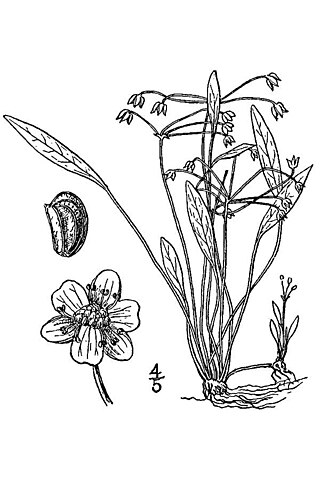
Helanthium tenellum, the pygmy chain sword, is a species of plants in the Alismataceae. It is native to the eastern United States, southern Mexico, West Indies, Central America, South America

Calopogon barbatus, the bearded grass-pink, is a species of orchid native to the southeastern United States, from Louisiana to North Carolina.
